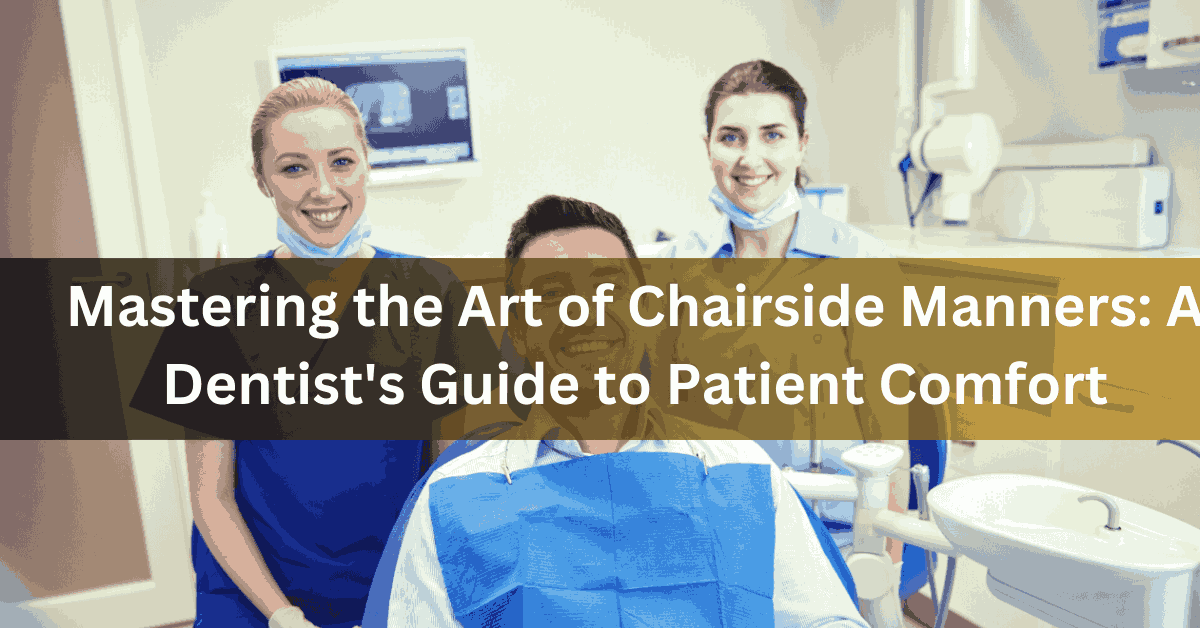Mastering the Art of Chairside Manners: A Dentist’s Guide to Patient Comfort
When it comes to dentistry, it’s not just about the technical skills and expertise but also about creating a comforting environment for patients.
The term “chairside manner” encompasses the way a dentist interacts with their patients, making them feel at ease during what can be an anxiety-inducing experience. This guide will explore the significance of mastering chairside manners and how dental dams can improve patient comfort.
The Human Touch in Dentistry
Imagine entering a dental clinic where the atmosphere is cold and clinical, and the dentist seems detached. Now, picture a scenario where the dentist warmly welcomes you, takes the time to understand your concerns, and explains procedures in a friendly, approachable manner. The latter is an embodiment of excellent chairside manners.
Patients often associate their dental experiences with anxiety and fear. However, a dentist who can establish a human connection and radiate empathy can significantly alleviate these feelings.
Simple gestures like a friendly greeting, maintaining eye contact, and actively listening to patients’ concerns go a long way in creating a positive and comfortable atmosphere.
The Impact of Patient Comfort
Patient comfort is not just a nicety; it directly affects the overall success of dental treatments. Patients who feel comfortable and relaxed are more likely to cooperate during procedures, leading to better outcomes.
Moreover, a positive experience encourages patients to maintain regular dental appointments, contributing to their long-term oral health.
The Role of Communication
Effective communication is at the heart of chairside manners. Dentists who can explain procedures, potential discomforts, and post-treatment care clearly and understandably help demystify the dental experience. This transparency builds trust and empowers patients to actively participate in their oral health journey.
Building Trust Through Information
Providing detailed information about dental procedures fosters a sense of trust between the dentist and the patient. When patients clearly understand what to expect, they are more likely to feel in control and less anxious.
Take the time to discuss treatment plans, potential outcomes, and any alternative options, ensuring that patients are well-informed partners in their own dental care.
Addressing Dental Anxiety Head-On
It’s no secret that dental anxiety is a common issue among patients. Acknowledging and addressing these fears directly can make a significant difference.
Dentists who take the initiative to discuss anxiety management strategies, such as relaxation techniques or the option of sedation, demonstrate a proactive approach to patient comfort. This open dialogue allows patients to express their concerns, paving the way for a more collaborative and stress-free experience.
Encouraging Questions and Active Participation
Creating an environment where questions are not just welcomed but encouraged is pivotal in effective communication. Dentists should actively invite patients to share their thoughts, concerns, or any uncertainties they may have.
This not only helps clarify misconceptions but also empowers patients to participate actively in decisions regarding their treatment. A collaborative approach to oral care enhances the overall patient experience.
Enhancing Patient Comfort with Dental Dams
One essential aspect of creating a comfortable and controlled environment during dental procedures is the use of dental dams.
These thin, flexible sheets made of latex or polyurethane serve as a protective barrier, isolating the tooth or teeth being worked on. While their primary function is infection control, they also contribute significantly to patient comfort.
Ensuring a Clean and Controlled Environment
These dams create a sterile field, preventing saliva, bacteria, and other contaminants from entering the treatment area. This not only enhances the effectiveness of dental procedures but also reduces the risk of post-treatment complications. Patients can be reassured that the environment is meticulously controlled, minimizing the chances of infection and promoting a smoother recovery process.
Reducing Sensory Overload
Using them also aids in reducing sensory overload for patients. The isolation of the treatment area minimizes visual stimuli, allowing patients to focus on the dentist’s instructions or simply relax without being overwhelmed by the dental environment. This controlled setting contributes significantly to a more comfortable and less stressful experience.
Practical Tips for Mastering Chairside Manner
Empathy Matters: Put yourself in your patient’s shoes. Acknowledge their fears and concerns, and show genuine empathy. A compassionate approach can do wonders in easing anxiety.
Clear Communication: Use simple language to explain procedures, potential discomforts, and aftercare. Encourage questions and address any concerns to ensure your patients are well-informed and feel in control.
Active Listening: Pay close attention to your patient’s concerns. By actively listening, you not only gather valuable information but also show that their feelings and questions are valid and important.
Create a Relaxing Environment: Consider elements like soothing music, comfortable seating, and pleasant décor in your dental office. These subtle touches contribute to an overall calming atmosphere.
Mindful Body Language: Non-verbal cues matter. Maintain a friendly and approachable demeanor, and be mindful of your body language. A warm smile and reassuring gestures can go a long way.
Conclusion
Mastering the art of chairside manners is more than just a professional skill; it’s an essential aspect of providing quality dental care. By prioritizing patient comfort through effective communication and empathy, dentists can transform dental visits into positive and reassuring experiences.
Remember, a comfortable patient is a cooperative patient, contributing not only to successful treatments but also to the long-term oral health of individuals.

